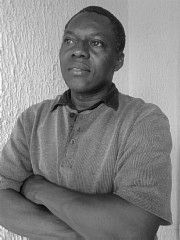Harrie Uvietobor Makpamiekun Bazunu

Harrie Bazunu is a sculptor and art historian by training, a scholar and fellow of the African Humanities Program (AHP) of the American Council of Learned Societies (ACLS). He is currently a Senior Lecturer in the Department of Fine and Applied Arts, Delta State University Abraka, where he also obtained his M.A. and PhD. in Art History (2006 and 2012 respectively). He also has a BA (1990) and an M.F.A. (1995), specializing in sculpture, from the University of Benin, Benin City, Nigeria. In his visual arts practice, Bazunu experiments with assorted plastics, polyfibre, thixotropics, repurposed aluminum cans, terracotta and iron. He has many commissions, art exhibitions, research publications and three curated exhibitions to his credit.
In 2010, Bazunu was awarded a Dissertation Completion Fellowship by AHP. This award brought his doctoral thesis “Semiotic Elements in Selected Artworks on the Niger Delta” to fruition. After his doctorate, and focusing on the Igun n’ Ugboha Blacksmiths of Benin Kingdom, his childhood obsession, he participated and won, in the highly competitive AHP Postdoctoral/Early Career Fellowship in 2013. He was in September 2014, one of the six fellows selected to participate in the AHP Manuscript Development Workshop in Tanzania.
Bazunu had a childhood of visual symbolism and communication. His mother, Victoria Iyayi Oghobaghase (1914-2016), was a traditional midwife and both Olokun and Sango priestess, (a practice she learned from her parents), taught him a lot about Edo and some Urhobo proverbs, and visual symbols. As a lad, young Bazunu watched his mother decorate her shrines with linear and curvilinear motifs; do divinations for clients/patients with kola-nuts on a plate of kaolin powder; and received guests in different manners: one of them being the use of a carved wooden tortoise as bowl, for presentation of kola-nuts to special guests and very important personalities. These made him ask questions about the symbolic significance of actions, forms and images in his, then ‘little’ world. This background of visual/symbolic communication thus began his quest for meanings assigned to visual forms, a preoccupation that led his research work to winning the grants/awards mentioned earlier.
Last Modified: Wed, 13 Sep 2017 14:41:03 SAST
